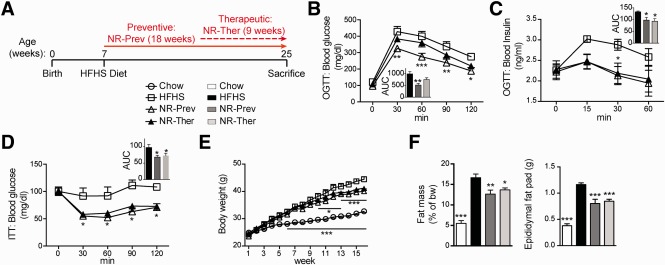Figure 2.

Glucose intolerance and NAFLD‐induced insulin sensitivity are reversed with NAD+ repletion. Phenotyping was performed on CD, HFHS, NR‐Prev, and NR‐Ther cohorts after 5‐18 weeks of treatment (NR dose: 400 mg/kg/day). (A) Schematic illustrating the three experimental groups; animals starting on an HFHS diet at 7 weeks of age are given NR in a preventive (NR‐Prev) mode for 18 weeks or 9 weeks in a therapeutic approach (NR‐Ther). Mice were sacrificed after a 4‐hour fast. The control chow‐diet regimen is not shown on the schematic. NR improved (B) glucose handling and (C) plasma insulin levels after an oral glucose tolerance test (OGTT; insets show the area under the curve [AUC]), measured after 15 weeks of diet (n = 5; chow‐diet regimen is not shown). NR also (D) improved insulin sensitivity during an insulin tolerance test (ITT), measured after 17 weeks of diet (n = 5; chow‐diet regimen is not shown) [Correction added February 3, 2016, after first online publication: “(mg/ml)” in Y axis of Fig. 2D was changed to “(mg/dl).”] and (E) reduced body weight (n = 8‐10). Both cohorts treated with NR exhibited lower (F) whole‐body fat mass, as measured by echo magnetic resonance imaging after 18 weeks of diet, and epididymal fat mass at sacrifice, compared to the HFHS cohort (n = 8‐10). *P < 0.05; **P < 0.001; ***P < 0.0001 compared to the HFHS cohort. Data are expressed as mean ± SEM. One‐way ANOVA with a post‐hoc Bonferroni test was used for all statistical analyses. Male mice were used for these experiments.
